What we’re thinking
Progress – a deceptively simple concept – is the beating heart of the progress economy. We are all trying to make progress in everything in our lives. Learning, moving, fixing, getting nourishment, are just some examples.
We’ll define it as:
progress: moving, over time, to a more desirable state
When we focus first on progress, rather than value, we improve our chances of innovation and sales success. In fact, we’ll see value as a set of progress comparisons; emerging only as progress is made.
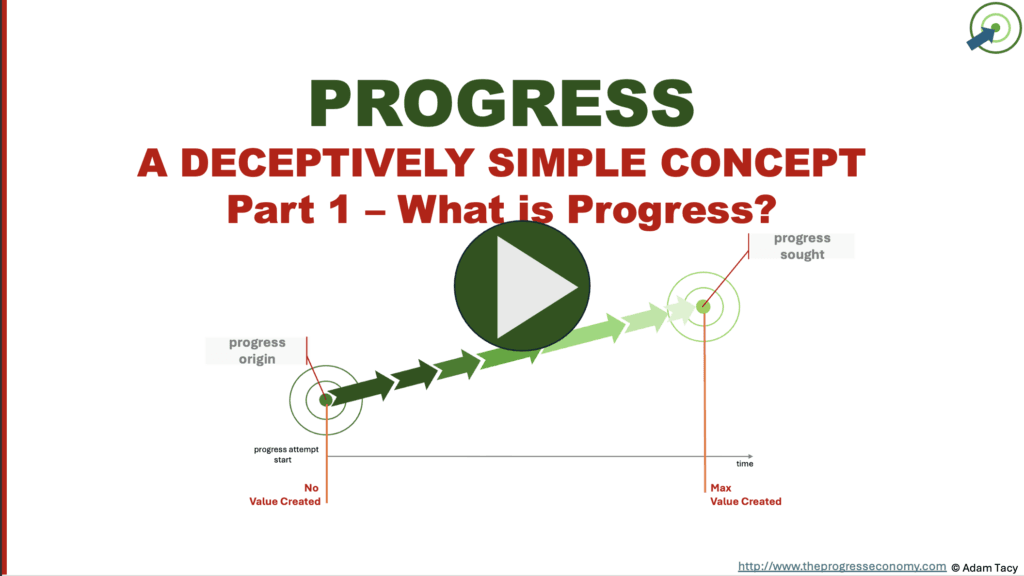
We’ll unlock the deepness of progress by viewing it in four ways, as a:
- verb – our moving over time to a more desired state
- state – functional, non-functional and contextual elements
- noun – names of useful states on the progress journey
- state transition – another useful way of observing progress similar to being a verb
Insightfully, a progress-first perspective explains job-to-be-done theories, Christensen’s “innovator’s dilemma“, Blue Ocean strategy, Drucker’s rallying call of “innovate or die”, and leads us to minimise value-in-exchange blind spots and Levitt’s marketing myopia; as well as much more. It provides the levers to make more successful innovations and sales.
Understanding progress is necessarily complex, but, trust me, much less complicated than it first sounds!
What is progress
Progress is a lens for understanding the world – leading us to insights solving the innovation problem, driving sales success, and accelerating growth. It is the horse that pulls the value cart, though we often make the mistake of prioritising value before progress.
Conceptually, we’ll define progress as:
progress: moving, over time, to a more desirable state
We are all progress seekers. Everything we do in life is an effort to reach a more desirable state. For example, progress could mean becoming fitter, learning a new language, transporting something to a new location, or increasing wealth. These examples point to four core categories of progress, relating to our:
- bodies
- possessions
- minds/mental state
- information/intangible assets
I’ve adapted these categories from Lovelock & Wirtz’s Services Marketing. There’s a relation between progress and service we’ll often explore (though service is not the opposite of goods; Service is “the act of applying your skills/knowledge for someone else’s benefit”; and your skills/knowledge might be held in you, a system, or in a goods (or even a location)). These categories help us conceptualise what we’ll come to call functional progress. We’ll also need to explore non-functional and contextual elements of progress.
While progress may seem a simple concept, that is deceptive. It forms the foundation of a rich operating system explaining how our world works – one that we propose leveraging to fix challenges in innovation, sales, and growth.
A deceptively simple concept
Here, in bullet point we explore how the simple concept of progress actually reveals that rich operating system:
- we’re all striving to make progress in all aspects of our lives (we’re progress seekers)
- we make progress attempts – executing a series of progress-making activities that are resource integrations – on a specific aspect of progress sought
- we often struggle to make progress due to a lack of resource – time, skills, knowledge, physical traits, tools, etc; this is the foundational progress hurdles
- some seekers attempt to progress even if the lack of resource hurdle is high; if they succeed they will have created/generated new resource(s); they may decide to offer those resources to other seekers (they have become a progress helper offering a progress proposition)
- progress helpers offer bundles of supplementary resources intending to reduce a seeker’s foundational lack of resource; we call these bundles progress propositions and they consist of i) a series of proposed progress-making activities and ii) a progress resource mix (some specific combination of employees/Ai, systems, data, goods, physical resources, locations)
- helpers offer their help to progress in exchange for help with progress they seek – we are all progress seekers, remember. This is not a barter economy. Commonly this exchange of help is obfuscated and mediated by service credits, of which cash is a successful implementation
And if you like descriptions in a more graphical way, we can view progress, and the four layer operating system it reveals, this way:
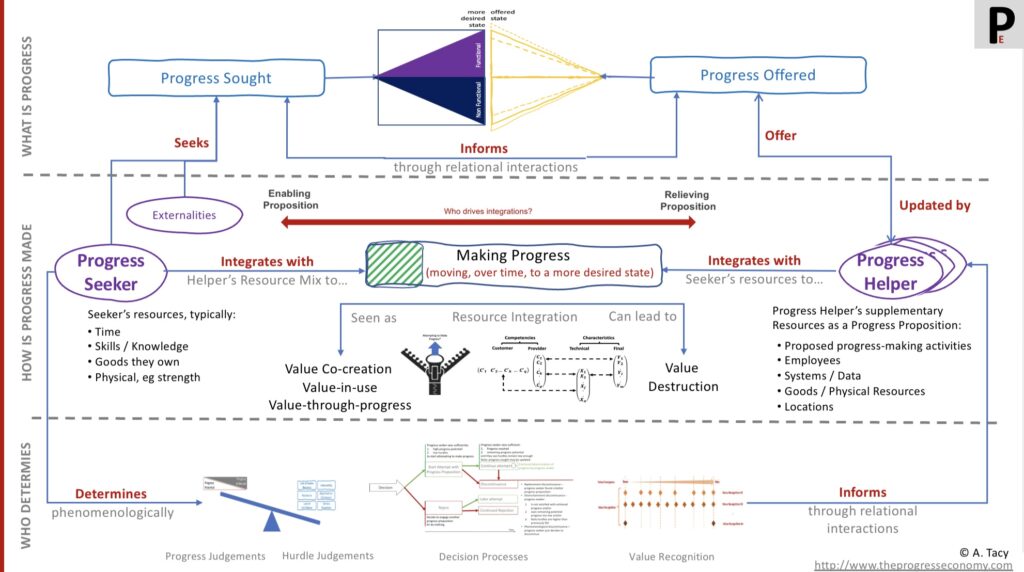
Placing progress in context
Here’s how we place progress in the context of the progress economy.

We see it four ways, as a:
- verb – our moving over time to a more desired state
- state – functional, non-functional and contextual elements
- noun – names of useful states on the progress journey
- state transition – another useful way of observing progress similar to being a verb
You may have noticed that in the progress economy, value is framed within the context of progress. This progress-first view offers a fundamental advantage over traditional value-first thinking – it helps us avoid the blind spots that come with the latter.
In this view, value is a set of progress comparisons: how much progress can I make vs. how much I want to make? How much progress have I made vs. what I expected by this point? And more.
Put simply, value emerges from the act of making progress.
But enough about value – let’s now explore the four core perspectives on progress, starting with progress as a state.
Progress as a State – snapshotting progress
What do we mean by ”state” in our progress definition?
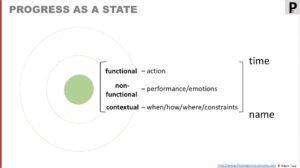
A progress state is a snapshot of progress at a specific moment in time, comprising three equally critical elements:
- functional – state of an progress attempt
- non-functional – performance and feelings
- contextual – when/where/constraints.
Functional progress
Consider the more desired state’s functional progress as the desired situation after progress is made: able to run a half marathon, fluent in a new language, arrived in Oslo, net worth increased by 10%. These would contrast with the functional state before progress, such as your current running ability.
While these capture functional outcomes, they do not account for non-functional progress.
Non-functional progress
Non-functional progress encompasses factors such as speed, safety, ease, enjoyment, flexibility, or the freedom to attempt progress when you want. For instance, the sense of achievement or the ability to progress without delays can be just as vital, sometimes more, as reaching the end goal.
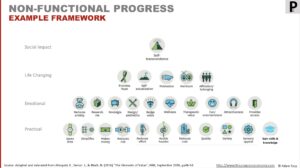
While the list of potential non-functional aspects is endless, only some are genuinely sought by progress seekers. It’s critical to identify the specific non-functional elements that matter to your seeker and avoid focusing on imagined needs.
For a structured approach, we can reference the hierarchy produced by Almquist, Senior, and Bloch, which uncovers various elements of what they call value. Most of their insights relate to non-functional progress considerations.
The importance of Contextual element of progress
Finally, progress is shaped by its context—the conditions and constraints that impact how progress is pursued. Examples include “no driver’s license” or “in rush hour.” Context is essential to understanding progress, as Christensen has noted:
A job can only be defined – and a successful solution created – relative to the specific context in which it arises
Christensen, C (2016) “Competing against luck”
Measuring state
Defining a state implies the ability to compare different states, which requires measurable criteria. Some state elements – particularly functional ones – are straightforward to measure. For example, if progress involves traveling a distance, we can measure it in kilometers, miles, or even light-years.
However, other state elements are less easily quantified. Take language fluency, for example. Societies or governing bodies often introduce artificial scales to standardise measurement. The European Union, for instance, has an objective framework for assessing language competency.
Non-functional progress – aspects such as enjoyment, fulfillment, or perceived reward – can be more difficult to measure. Organisations often rely on qualitative methods like focus groups, surveys, and follow-up questionnaires to gauge these elements.
Misunderstanding, or not recognising, non-functional or contextual elements of progress sought will impact success of your progress proposition. Supermarket self-checkouts, is a good example of where there is misunderstood non-functional and contextual progress.
These three elements also allow us to discover better market segmentation – beyond the product feature or demographic approaches usually used today.
Progress as a Noun – naming waypoints and judgements of progress.
Naming key progress states helps us more effectively discuss the progress journey.
It simplifies conversations about moving from a seeker’s progress origin to their progress sought, as well as identifying where they are along the way—their progress position.
We can also talk about a progress proposition offering to help reach a state we call progress offered from the proposition’s origin. Where both may differ from a seeker’s progress sought and origin.
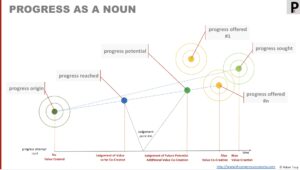
Two named states – progress reached and progress potential – are phenomenological judgements of progress that the seeker makes and uses in determining various facets of value (eg can I reach a sufficient amount of progress compared to my progress sought).
Progress as a Verb – attempting and making progress.
Getting fit, learning a language, moving, investing, these are all examples of seeing the (functional) progress as a verb. These actions represent the seeker’s journey from their progress origin to their progress sought.
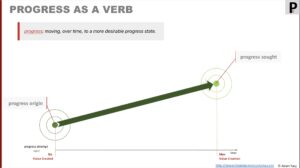
Seekers make this journey through a progress attempt – a series of progress-making activities. Each activity is one or more resource integrations involving:
- Seeker’s time
- Seeker’s knowledge and skills
- Tools/goods the seeker currently has available to them
However, a seeker may lack, or feel they do, the necessary resources. This is the foundational progress hurdle: the lack of resource hurdle. This can cause seekers to either avoid starting or abandon their progress attempt. This is where progress helpers come into the picture.
The Role of Progress Helpers
We call lack of resource a hurdle, rather than barrier, since some seekers attempt progress anyway. If they succeed in progrssing, they have created/generated new resources. They may then decide to offer those resources to other seekers – they become progress helper with a progress proposition. Sometimes seekers deliberately look for progress to attempt that has a lack of resource in order to generate new resources to offe.
Progress helpers, then, offer supplementary resources to overcome this lack of resource hurdle. These helpers typically offer two key resource bundles:
- a proposed series of progress-making activities
- a progress resource mix (some combination of employees/AI, systems, data, goods, physical resources, locations.
Now the progress-making resource integrations are between seeker’s and helper’s resources and are driven by some combination of seeker and helper. These propositions sit on a continuum between relieving – where the helper executes all the activities – and enabling – where the seeker is driving all the integrations.
Interestingly, propositions introduce 5 additional progress hurdles: adoptability, resistance, lack of confidence, continuum misalignment, inequitable exchange. Each needing to be minimised to below an individual seeker’s tolerance to not affect likelihood of use.
We should also be aware that propositions go from their own progress origin to their own state of progress offered, these may not fully align with the seeker’s original state or their progress sought. Too much of a difference and the Seeker may fail to see how they make progress with the proposition.
Some notes of non-functional and contextual progress
Non-functional and contextual progress elements also play a critical role. Interestingly, some non-functional elements, like “safety,” would remain constant throughout the entire progress journey. Others, such as a “sense of achievement,” you would expect to improve as the journey progresses.
Contextually, we make a convention that this does not change during a progress journey. If context needs to change it should be reframed as the functional/non functional element of another progress journey.
For contextual elements – typically constraints – we make the convention that they are fixed for the duration of a specific progress journey. If a change in context is necessary, it should be reframed as the functional or non-functional element of a separate progress journey.
For example, the travelling constraint of ”no driving license” is better addressed through a new progress sought of ”gained driving license” than through trying to address in the ”travel to Oslo” functional progress attempt.
The process of making progress can also be seen more state-like as a series of state transitions.
Progress as a State Transition – a useful alternative view
Since we move between states, we can also see progress as a series of state transitions.
This is an alternative, but equivalent way of seeing progress as a verb which is sometimes useful to use when looking at or describing progress.
Here, for example, we can see some of the progress judgements that lead to understanding value; or that we don’t expect contextual progress to change under a progress attempt.
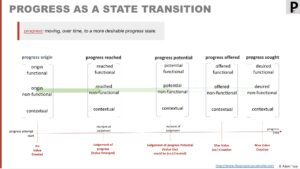
That’s our four ways of looking at progress. As a state helping us understand the details and nuances; as a noun naming important points on the journey; as a verb and a state helping us understand that progress journey and attempts.
Our view of progress happily provides a unified home for many business theories from over the decades.
Welcome home some key business theories
Taking a progress-first view nicely explains a number of important business theories. Let’s take a quick run through these.
UPDATING AND SIMPLIFYING
“Job to be done”
Both Ulwick’s and Christensen’s “jobs to be done” theory recognise that customers aren’t just purchasing goods and services; they’re seeking to fulfill specific tasks or jobs.
Ulwick mentions:
People want products and services that will help them get a job done better and/or more cheaply
What is jobs to be done,
Christensen says:
Successful innovations help consumers to solve problems – to make the progress they need to…
Know Your Customers’ “Jobs to Be Done”, HBR
And
We define a ”job” as the progress that a person is trying to make in a particular circumstance
Christensen, C. M., Dillon, K., Hall, T., Duncan, D. S. (2016) ”Competing Against Luck: The Story of Innovation and Customer Choice” Harper Business; 1 edition
The coupling of progress sought, progress origin and progress as a verb let us describe, in deeper detail, the job to be done, and the definition of done. The progress economy also tells us conceptually how the job should be done, what may hinder it, how someone can help and what challenges that brings. All working together to supercharge innovation and sales.
Levitt’s Marketing Myopia
Drucker’s ”Innovate or Die”
Seekers are constantly gaining new resources and raising their expectations of progress potential through the progress attempts they make – not just in your industry, but across all industries and markets. Rising expectations evolves their progress sought; gaining resources changes their origin.
This is a challenge to progress propositions, who’s:
- progress origin fall behind the seekers – leading to over resourcing, and potential seeker frustration at time/progress wasted
- progress offered fall behind progress sought – leading to lower offered vs sought comparison (a part of value judgements)
To stay attractive, progress helpers must adapt their propositions.
A direct succinct explanation of this is Drucker’s enduring insight:
Innovate or die
P. Drucker, via “Innovation on the fly”, HBR
Disruptive innovation (The Innovator’s dilemma)
Whilst the progress economy explans ”innovate or die”, Christensen warns us of the innovator’s dlimma and the impact of disruptive innovation. The progress economy also explains this.
Blue Ocean Strategy
Kim & Maugborne describe Blue Ocean Strategy as
the simultaneous pursuit of differentiation and low cost to open up a new market space and create new demand. It is about creating and capturing uncontested market space, thereby making the competition irrelevant
https://www.blueoceanstrategy.com/what-is-blue-ocean-strategy/
Relating to value
Let’s take 1970’s disco composer extraordinaire Giorgio Moroder’s advice.
Once you free your mind about a concept of harmony and of music being correct you can do whatever you want
Giorgio Moroder
When we free our minds from the deeply embedded concept that manufacturers embed value and we exchange that for cash, we find that:
- Reaching their progress sought creates maximum possible value for a seeker
- There is no value at their progress origin
Value, then, incrementally emerges as the seeker moves over time between their progress origin and progress sought. There is value-through-progress.
value-through-progress: a view of value creation that sees value as being increasingly created as progress is made. Though any value created may not be recognised (accounting term) until progress completes.
We say that value is a trailing indicator for progress. It’s not value we try and create, it is progress.
If a seeker engages a proposition, then progress is a joint endeavour. Seeker and helper co-create value. We often referred to this as value-in-use. Though the maximum value co-created with a proposition is likely to be different than progress sought.
Interestingly, emerged value is not meaningful to a seeker. They need to recognise it for it to become meaningful. Value recognition is a process similar to revenue recognition, that anyone with a finance background will be familiar with.
Although a seeker’s schedule for recognition may differ from the continuous emergence of value. For example, it could occur:
- periodically
- at the end of each progress making activity
- when reaching milestones
- only when reaching progress sought (or offered)
Relating to innovation
Innovation should enable a seeker to reach as close to their progress sought as possible. Since that is where maximum value has emerged. Failing that, innovation should enable the seeker to make the progress currently possible in a better way. Practically both these require reducing the lack of resource progress hurdle.
Seekers may attempt to improve their progress themselves. They may design and try different progress-making steps. Or utilise existing resources they have access to in novel ways. Perhaps they find new resources in their environment, or acquire them in seemingly unrelated progress attempts. They may even engage progress propositions in a novel manner.
Helpers, likewise, look to innovate their propositions. Aiming to help seekers reach further or make progress currently possible better. Or to close the gap between seekers’ and proposition’s assumed progress origin. They may additionally reduce the five additional progress hurdles that progress propositions introduce.
Finally, we observe that innovation is continuously required. It is driven by the fact that progress sought continuously evolves. It is shaped by seekers’ experiences in attempting progress in various aspects of life, including in other industries, markets, and global perspectives. As well as their observations of others attempting progress. Similarly seekers’ progress origins can shift over time.
Although innovating to chase the evolving progress sought of your most demanding seekers may expose you to be disrupted. That’s part of Christensens “Innovator’s dilemma“.



Let’s progress together through discussion…